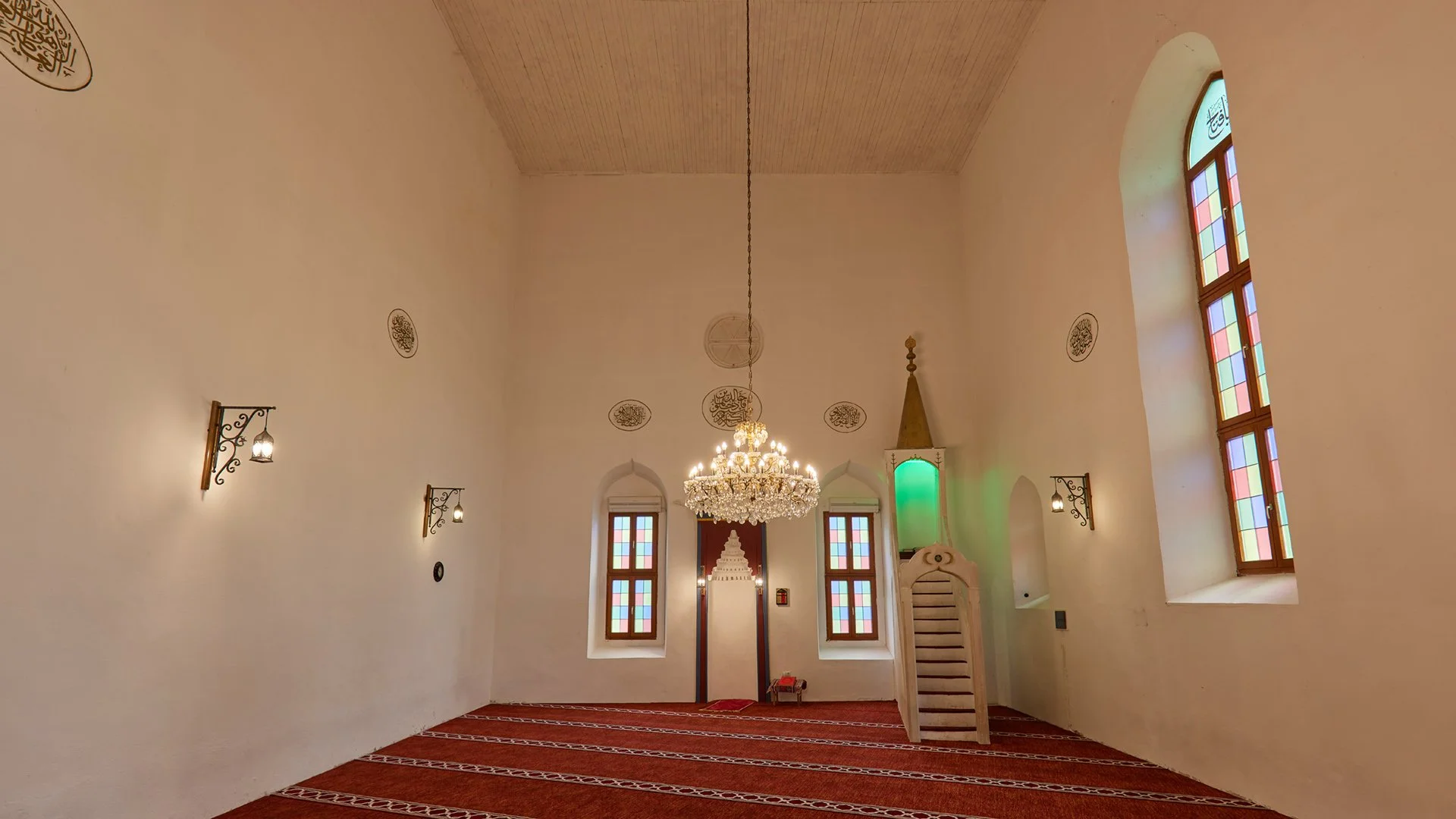
FETHIJA MOSQUE IN BIHAĆ
Author: Suad Mahmutović, MA, Islamski pedagoški fakultet u Bihaću (Islamic Pedagogical Faculty in Bihać) • Photo and video: Mirza Hasanefendić
Fethija Mosque is situated in the main city square in Bihać. It was built of the carved stone bihacit, same as many other buildings in Bosanska Krajina. Her base consists of a 22m long and 11.50 m wide rectangle and it is 10.50 m high. It was built of carved blocks of the bihacit stone, which abounds in Bihać surroundings. The outer surface of the stone is nicely polished. Walls in the base are 1.10 to 1.20 m thick. The walls end with a cornice which extends along the whole building, except at the part where the minaret passes through. The inner dimensions of the building are 20.80 m in length and 9.13 m in width. On the outer walls there are 16 different carver signs, which means that a large number of carvers were engaged in building it.
The present Fethija Mosque used to be the Church of Saint Anthony of Padua. It has been recorded that Bihać suffered a great fire in 1578, when many buildings, including churches, burned down. It has also been recorded that, in 1586, only bare walls without the roof remained of both churches, Dominican and Franciscan. It was the devastated Church of Saint Anthony that Ottomans found when they conquered Bihać in 1592.
The architecture of the building was preserved, though minor interior adjustments were made for the new function of the mosque. To this end, the belfry of the church was adjusted. The mosque was renewed in the second half of the 19th century, when the minaret was built. At the base of the minaret, there is an old inscription engraved on a stone slab: During the noble rule of the ace of the Ottoman family, a patron of faith, a supporter of towns, our lord sultan Abdul Aziz-han, this minaret was built, which has no equal, and the honorable mosque was renewed (year 1280, Hijri –1863, written by feeble Hilmi, kaymakan of Bihać).
There is another slab on the mosque, on which the following is written: Ja Fettah (Oh, You who conquer)! This honorable mosque badly needed repair, and with the financial aid of the state and aid of the Elahija, its roof was renewed and its interior was fully painted and decorated (the renewal was successfully finished in 1312 Hijri year - in 1894 according to the Gregorian calendar). The entire interior of the mosque was then painted, mostly with floral elements.
Fethija Mosque obtained lighting in 1914, and it cost 1,561 kunas at the time. Muhamed-bey Bišćević donated 340 kunas for this purpose, a loan from Central Bank amounted to 1,021 kunas and Elahija contribution to 200 kunas.
In their letter number 520 of 5.9.1914, district administration in Bihać informed administration in Sarajevo that electrification of the Fethija Mosque in Bihać and its minaret had been fully completed.
Franjo Josip Street with the Fethija Mosque in Bihać
In the Second World War, the two-floor mahfil (balcony) completely burned down, and it was not used for years. Šerefa (railing) of the minaret was also damaged in 1945, but it was repaired in the following year. Since the roof leaked, Institute for the Protection of Cultural Monuments took measures in 1953 to make certain repairs. In the following year, in 1954, the minaret was renewed, while the ceiling and roof, as well as parts of the stone cornice were repaired in 1966.
Two years later, in 1968, works on the interior of the mosque were done: new windows were provided, mahfil was repaired and walls were repainted white. Unfortunately, the entire decoration of the interior part of Fethija was destroyed in this way.
After the Second World War the Fethija Mosque served as a warehouse for the purchase of agricultural products, which was confirmed by several older respectable Bihać inhabitants. Fethija Mosque was put under state protection, with the limitations pursuant to Articles 2. and 4. of the Law on the Protection of Cultural and Natural Heritage and was entered in the Register of Immovable Cultural Monuments. Nevertheless, during the latest aggression on Bosnia and Herzegovina, Fethija was shelled several times and was significantly damaged, particularly the roofing. It was astounding to learn about the fact that this mosque was one of the “legitimate military targets” of the so-called Army of Republika Srpska, and was recorded as C 82 in the Overview of Targets of Howitzers of 105 mm artillery of the 15th light infantry brigade of the Army of RS, which was described by Mujo Begić, PhD, in his book U opsadi 1201 dan – Sigurna zona UN-a Bihać (In the 1201-day Siege – UN Safety Zone Bihać), published in 2013. Besides Fethija, mosques in Ribić and Vinica were also marked as military targets.
Overview of 105mm artillery howitzer targets by 15. lpbr of so-called VRS
The roof of the mosque was renewed in 2000. Fethija Mosque in Bihać has an extremely significant historical value. It is the only mosque in Bosnia and Herzegovina that bears this name. The other three fethija mosques, those in Jajce, Zvornik and Srebrenica, have been completely destroyed.
Activities on the reconstruction of Fethija in Bihać are in progress. We believe that old ornaments from the 19th century will be placed back on this building of the first category, which has the national significance. It requires thorough restoration of the Fethija Mosque, involvement of the professionals, willingness of both the jamaat members and the social community in general.






























